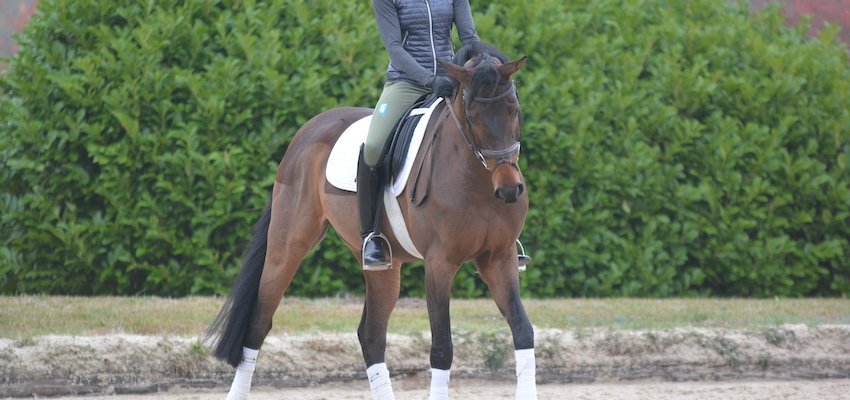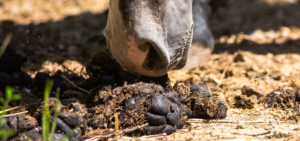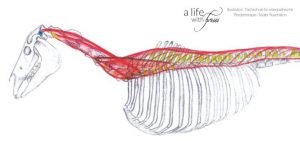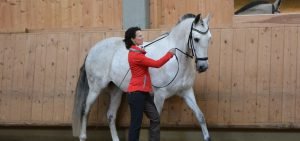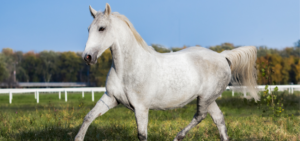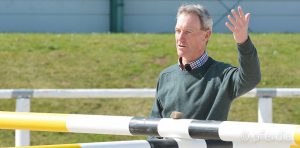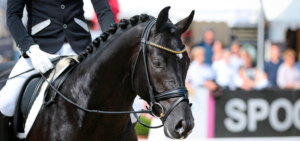Flexibility. It’s one of our most important traits. Life is all about flexibility. Whether it’s preparing for a last-minute meeting, dealing with a change in plans for your dinner date, or simply embracing a spontaneous moment during this great adventure we call life, everyone needs to be flexible. Everyone needs to have a little bend. So do horses; especially in the complex arena of the world of dressage.
Summary
- What Exactly is Bending Horses?
- Why is Developing Bending Horses Important?
- What are the Bending Aids? How does a Rider Accomplish Bending Horses?
- No Bananas!
- What are some Effective Horse Bending Exercises?
- Above All, Good Health: Safety in Bending Horses
- The Bending Horse is a Softer Horse
What Exactly is Bending Horses?
Merrium-Webster defines flexibility as, ‘the quality of bending without easily breaking’. Bend then refers to an object, or living thing’s ability to ‘incline the body downward from the vertical’, which is an intriguing definition as so often dressage riders are faulted for their horses being ‘behind’ the vertical.
However, bending horses does not refer to them being behind the vertical, or in reference to a horse that has come off-contact from the bit, but rather, a bending horse whose body is supple and flexible enough to engage in lateral curvature all the way from poll to tail, as he navigates any given course.
Why is Developing Bending Horses Important?
Bending horses is important for several reasons. First, bending with horses indicates suppleness and balance. Proper bending techniques showcase the control a rider has over his horse, as well as the strength and athleticism of the prospect being ridden.
While bending horses soften laterally around a rider’s leg while maintaining his forward momentum and overall balance, in turn the rider with find more softness, more suppleness in all other maneuvers. When the horse’s body becomes soft and responsive to each cue, each nuance of the rider, the horse becomes softer in the mouth and reaches a new level of mastery. That, is the power of the bend.
What are the Bending Aids? How does a Rider Accomplish Bending Horses?
Riders have three important aids that allow them to successfully achieve bending with horses. Those three aids are as follows:
- Inside leg at the girth
- Outside leg behind the girth
- Outside rein
The inside rein alone does not aid in accomplishing bending in horses. In fact, utilization of the inside rein often contributes to the detriment of bend, as use of the inside rein will result in a lot of bend in the neck, typically, with little or no bend accomplished with the horse’s body. Learn more about the different riders aids here.
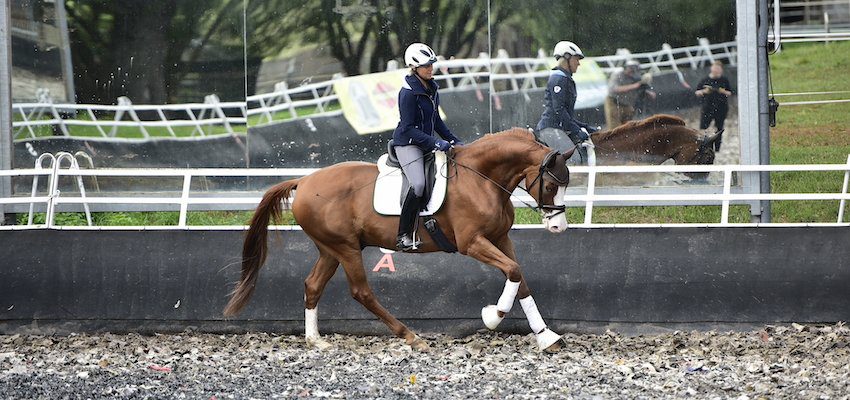
No Bananas!
Like humans, while bending horses nearly always have a preferred side. They will want to be what many members of the dressage community refer to as, ‘bananas’. While bending horses quite naturally prefer to move in one given direction, but will tend to struggle with bend in the opposite direction.
Trainers must then support the horse in developing his ability to bend equally on both sides, developing equal muscle tone, suppleness and flexibility and having a direct and significant impact on the horse’s overall balance. As a horse’s overall balance lies at the foundation of the philosophy of dressage, this development is critically important to a horse’s performance in the discipline.
What are some Effective Horse Bending Exercises?
Most dressage riders seek to improve the bend in their horses. That is, they want to support their horses in developing the ability to flex from poll to tail and improve their horses’ suppleness and flexibility. Strength and muscle tone play a tremendous role in bending for horses.
The horse requires physical strength to be able to curve his body while in motion if he is to maintain his overall balance by keeping his legs underneath his body and maintaining forward movement, collection, and impulsion.
There are a variety of ways to support a bending horse as he develops the ability to navigate any course or pattern while properly bending. With there being no singular correct course of action, there truly is no limit to the type of exercises one can develop and utilize during any given training program, though it is critically important to simultaneously ensure the safety and well-being of the horse as he develops his muscle tone, strength, and bend.
Above All, Good Health: Safety in Bending Horses
Like any exercise a horse is asked to engage in, it is critically important to always remain keenly cognizant of the risk of injury and soreness that could potentially result from any given training regimen. As mentioned, horses tend to bend more dominantly on one side, and as a result, the opposing side will be somewhat weak at the beginning stages of bending for horses.
Most suppleness and bending exercises require a horse’s body to flex quite a bit while he is engaged in forward motion. These movements can be incredibly taxing on the horse’s body, and should be used in moderation, especially in the beginning stages.
As a result, it is incredibly important that riders and trainers remain ever aware of their horses’ well-being and safety during these activities. Here are three helpful exercises to use in the development of a horse’s bending:
Exercise 1: Varying Circles, Spiraling Exercises
One activity that can be quite advantageous in the development of bending requires a horse to complete a variety of circles, all while maintaining an overall, equal bend throughout his body. Varying the size and speed of the circles will provide the horse with different degrees of bend, and different speeds with which to accomplish those bends.
During these exercises, it is important to remember to work the horse equally in both directions to engage muscles on both sides of his body equally and develop even bending while promoting balance and overall suppleness and flexibility.
Exercise 2: Leg Yielding
Leg yielding exercises can really get horses to drive up under themselves while still remaining supple and balanced and aware of the rider’s aids. There are many ways to engage a horse in leg yielding, but to begin, the rider can ask the horse to yield using the wall.
The first time, it’s best to begin at the walk. While maintaining forward momentum, the rider needs to walk straight down the line, for example, tracking left.
With the outside rein, in this example, the right rein, the rider needs to ask the horse to flex to the outside, slightly away from his direction of travel.
The rider needs to keep the horse moving forward using her left leg while at the same time using the right leg to cue the horse to take a step sideways, towards the center of the arena. It is imperative that upon that step, the rider immediately gives, rewarding the correct response from the horse and allowing him to escape the pressure.
Again, to promote equal bend and good overall balance, ensure that you are engaging the horse as equally as possible in leg yielding exercises moving in both directions. Although he will almost definitely naturally prefer one direction of travel over another, it is important to practice both directions as equally as possible.
Exercise 3: Counter-bend
Asking a horse to bend and counter-bend on a circle also works to improve the softness of his body and the flexibility and suppleness with which he is able to move.
Working in various size circles and gradually being able to increase the speed with which you are traveling, alternate in asking the horse to complete a circle, or a portion of a circle by bending and then alternatively, counter-bending.
This works in developing his overall responsiveness to your cues while simultaneously balancing out his ability to bend both sides equally.
Though this can be quite challenging for you both, the effects these types of exercises can produce are quite extraordinary. Be sure to take your time and complete the exercises carefully to ensure proper bend and execution of technique.
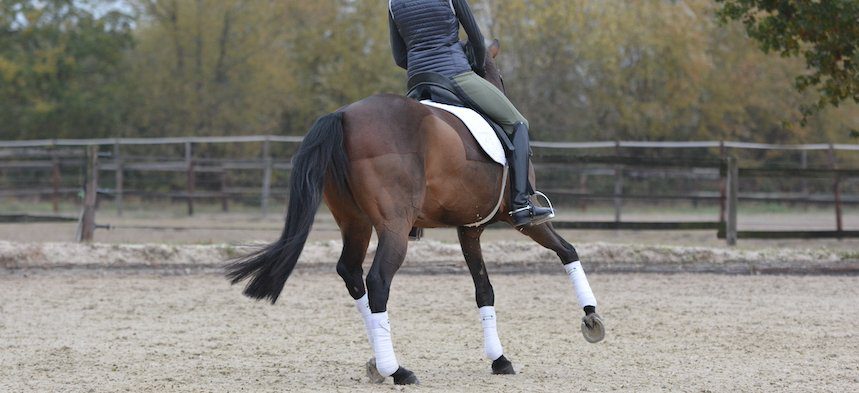
The Bending Horse is a Softer Horse
Bending horses is a integral component of exceptional dressage technique. By engaging your horse in a variety of bending exercises, you are supporting the development of body and mind, of softness and responsiveness and togetherness that all works harmoniously in creating a dressage horse capable of the greatness he has always had within.
Though developing bend may not always feel easy, often it is said that nothing of worth is ever easy, and as valuable as your horse is likely to you, the challenge is often what the adventure is all about.
Discover many more exercises and helpful tips for developing a bending dressage horse from selected trainers on our website.

